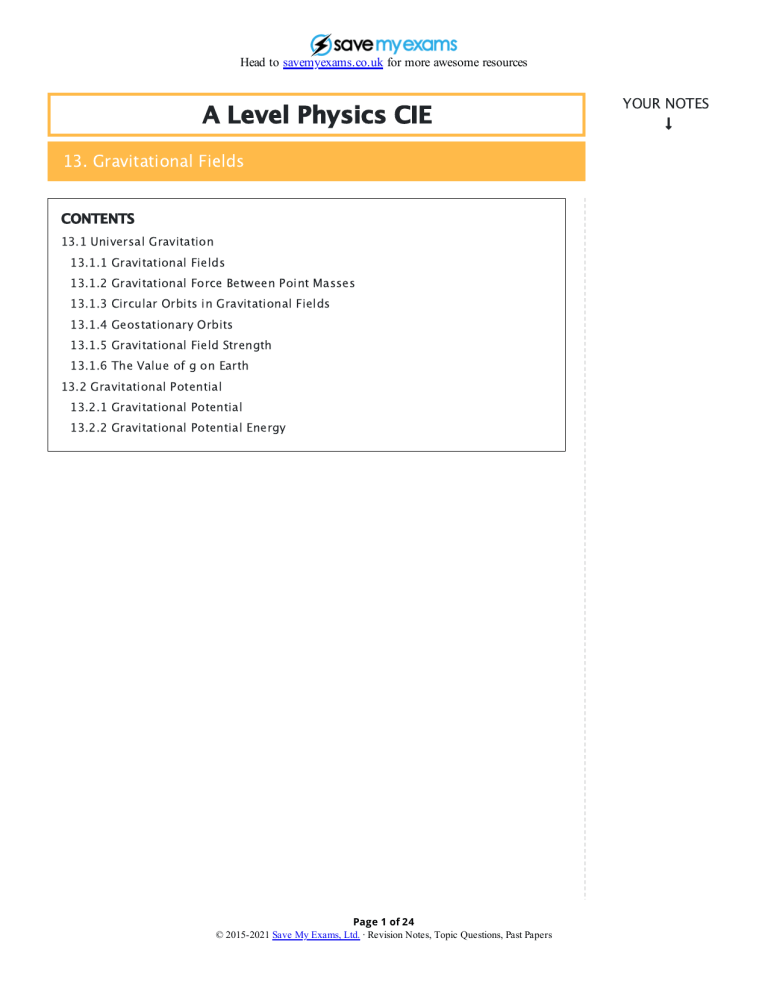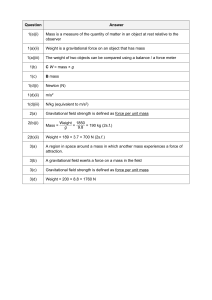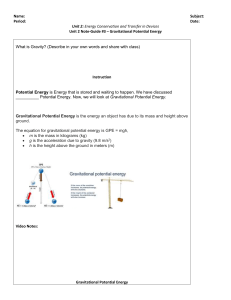
Head to savemyexams.co.uk for more awesome resources A Level Physics CIE 13. Gravitational Fields CONTENTS 13.1 Universal Gravitation 13.1.1 Gravitational Fields 13.1.2 Gravitational Force Between Point Masses 13.1.3 Circular Orbits in Gravitational Fields 13.1.4 Geostationary Orbits 13.1.5 Gravitational Field Strength 13.1.6 The Value of g on Earth 13.2 Gravitational Potential 13.2.1 Gravitational Potential 13.2.2 Gravitational Potential Energy Page 1 of 24 © 2015-2021 Save My Exams, Ltd. · Revision Notes, Topic Questions, Past Papers YOUR NOTES Head to savemyexams.co.uk for more awesome resources 13.1 Universal Gravitation 13.1.1 Gravitational Fields Defining Gravitational Field There is a force of attraction between all masses This force is known as the ‘force due to gravity’ or the weight The Earth’s gravitational field is responsible for the weight of all objects on Earth A gravitational field is defined as: A region of space where a mass experiences a force due to the gravitational attraction of another mass The direction of the gravitational field is always towards the centre of the mass Gravitational forces cannot be repulsive The strength of this gravitational field (g) at a point is the force (Fg) per unit mass (m) of an object at that point: Where: g = gravitational field strength (N kg-1) Fg = force due to gravity, or weight (N) m = mass (kg) This equations tells us: On planets with a large value of g, the gravitational force per unit mass is greater than on planets with a smaller value of g On such planets such as Jupiter, an object's mass remains the same at all points in space. However, their weight will be a lot greater meaning for example, a human will be unable to fully stand up Page 2 of 24 © 2015-2021 Save My Exams, Ltd. · Revision Notes, Topic Questions, Past Papers YOUR NOTES Head to savemyexams.co.uk for more awesome resources YOUR NOTES A person’s weight on Jupiter would be so large a human would be unable to fully stand up Example Worked Calculate the mass of an object with weight 10 N on Earth. Tip Exam There is a big difference between g and G (sometimes referred to as ‘little g’ and ‘big G’ respectively), g is the gravitational field strength and G is Newton’s gravitational constant. Make sure not to use these interchangeably! Page 3 of 24 © 2015-2021 Save My Exams, Ltd. · Revision Notes, Topic Questions, Past Papers Head to savemyexams.co.uk for more awesome resources Representing Gravitational Fields The direction of a gravitational field is represented by gravitational field lines The gravitational field lines around a point mass are radially inwards The gravitational field lines of a uniform field, where the field strength is the same at all points, is represented by equally spaced parallel lines For example, the fields lines on the Earth’s surface Gravitational field lines for a point mass and a uniform gravitational field Radial fields are considered non-uniform fields The gravitational field strength g is different depending on how far you are from the centre Parallel field lines on the Earth’s surface are considered a uniform field The gravitational field strength g is the same throughout Tip Exam Always label the arrows on the field lines! Gravitational forces are attractive only. Remember: For a radial field: it is towards the centre of the sphere or point charge For a uniform field: towards the surface of the object e.g. Earth Page 4 of 24 © 2015-2021 Save My Exams, Ltd. · Revision Notes, Topic Questions, Past Papers YOUR NOTES Head to savemyexams.co.uk for more awesome resources Point Mass Approximation For a point outside a uniform sphere, the mass of the sphere may be considered to be a point mass at its centre A uniform sphere is one where its mass is distributed evenly The gravitational field lines around a uniform sphere are therefore identical to those around a point mass An object can be regarded as point mass when: A body covers a very large distance as compared to its size, so, to study its motion, its size or dimensions can be neglected An example of this is field lines around planets Gravitational field lines around a uniform sphere are identical to those on a point mass Radial fields are considered non-uniform fields So, the gravitational field strength g is different depending on how far you are from the centre of mass of the sphere Page 5 of 24 © 2015-2021 Save My Exams, Ltd. · Revision Notes, Topic Questions, Past Papers YOUR NOTES Head to savemyexams.co.uk for more awesome resources 13.1.2 Gravitational Force Between Point Masses Newton's Law of Gravitation The gravitational force between two bodies outside a uniform field, e.g. between the Earth and the Sun, is defined by Newton’s Law of Gravitation Recall that the mass of a uniform sphere can be considered to be a point mass at its centre Newton’s Law of Gravitation states that: The gravitational force between two point masses is proportional to the product of the masses and inversely proportional to the square their separation In equation form, this can be written as: The gravitational force between two masses outside a uniform field is defined by Newton’s Law of Gravitation Where: FG = gravitational force between two masses (N) G = Newton’s gravitational constant m1 and m2 = two points masses (kg) r = distance between the centre of the two masses (m) Although planets are not point masses, their separation is much larger than their radius Therefore, Newton’s law of gravitation applies to planets orbiting the Sun Page 6 of 24 © 2015-2021 Save My Exams, Ltd. · Revision Notes, Topic Questions, Past Papers YOUR NOTES Head to savemyexams.co.uk for more awesome resources The 1/r2 relation is called the ‘inverse square law’ This means that when a mass is twice as far away from another, its force due to gravity reduces by (½)2 = ¼ Example Worked A satellite with mass 6500 kg is orbiting the Earth at 2000 km above the Earth's surface. The gravitational force between them is 37 kN.Calculate the mass of the Earth.Radius of the Earth = 6400 km. Tip Exam A common mistake in exams is to forget to add together the distance from the surface of the planet and its radius to obtain the value of r. The distance r is measured from the centre of the mass, which is from the centre of the planet. Page 7 of 24 © 2015-2021 Save My Exams, Ltd. · Revision Notes, Topic Questions, Past Papers YOUR NOTES Head to savemyexams.co.uk for more awesome resources 13.1.3 Circular Orbits in Gravitational Fields Circular Orbits in Gravitational Fields Since most planets and satellites have a near circular orbit, the gravitational force FG between the sun or another planet provides the centripetal force needed to stay in an orbit Both the gravitational force and centripetal force are perpendicular to the direction of travel of the planet Consider a satellite with mass m orbiting Earth with mass M at a distance r from the centre travelling with linear speed v Equating the gravitational force to the centripetal force for a planet or satellite in orbit gives: The mass of the satellite m will cancel out on both sides to give: This means that all satellites, whatever their mass, will travel at the same speed v in a particular orbit radius r Recall that since the direction of a planet orbiting in circular motion is constantly changing, it has centripetal acceleration A satellite in orbit around the Earth travels in circular motion Kepler’s Third Law of Planetary Motion Page 8 of 24 © 2015-2021 Save My Exams, Ltd. · Revision Notes, Topic Questions, Past Papers YOUR NOTES Head to savemyexams.co.uk for more awesome resources For the orbital time period T to travel the circumference of the orbit 2πr, the linear speed v can be written as This is a result of the well-known equation, speed = distance / time Substituting the value of the linear speed v into the above equation: Rearranging leads to Kepler’s third law equation: The equation shows that the orbital period T is related to the radius r of the orbit. This is known as Kepler’s third law: For planets or satellites in a circular orbit about the same central body, the square of the time period is proportional to the cube of the radius of the orbit Kepler’s third law can be summarised as: Maths Tip The ∝ symbol means ‘proportional to’ Find out more about proportional relationships between two variables in the “proportional relationships ” section of the A Level Maths revision notes Example Worked A binary star system constant of two stars orbiting about a fixed point star of mass M1 has a circular orbit of radius R1 and mass M2 has a radius of R2. Both have linear speed v and an angular speed ⍵ about B. B.The State the following formula, in terms of G, M2, R1 and R2 (i) The angular speed ⍵ of M1 (ii) The time period T for each star in terms of angular speed ⍵ (1) The angular speed of ⍵ of M1 Page 9 of 24 © 2015-2021 Save My Exams, Ltd. · Revision Notes, Topic Questions, Past Papers YOUR NOTES Head to savemyexams.co.uk for more awesome resources Step 1: Equating the centripetal force of mass M1 to the gravitational force between M1 and M2 Step 2: M1 cancels on both sides Step 3: Rearrange for angular velocity ⍵ Step 4: Square root both sides (2) The time period T for each star in terms of angular speed ⍵ Step 1: Angular speed equation with time period T Step 2: Rearrange for T Step 3: Substitute in ⍵ Tip Exam Many of the calculations in the Gravitation questions depend on the equations for circular motion. Be sure to revisit these and understand how to use them! Page 10 of 24 © 2015-2021 Save My Exams, Ltd. · Revision Notes, Topic Questions, Past Papers YOUR NOTES Head to savemyexams.co.uk for more awesome resources 13.1.4 Geostationary Orbits Geostationary Orbits Many communication satellites around Earth follow a geostationary orbit This is a specific type of orbit in which the satellite: Remains directly above the equator, therefore, it always orbits at the same point above the Earth’s surface Moves from west to east (same direction as the Earth spins) Has an orbital time period equal to Earth’s rotational period of 24 hours Geostationary satellites are used for telecommunication transmissions (e.g. radio) and television broadcast A base station on Earth sends the TV signal up to the satellite where it is amplified and broadcast back to the ground to the desired locations The satellite receiver dishes on the surface must point towards the same point in the sky Since the geostationary orbits of the satellites are fixed, the receiver dishes can be fixed too Geostationary satellite in orbit Page 11 of 24 © 2015-2021 Save My Exams, Ltd. · Revision Notes, Topic Questions, Past Papers YOUR NOTES Head to savemyexams.co.uk for more awesome resources YOUR NOTES Worked Example Calculate the distance above the Earth's surface that a geostationary satellite will orbit.Mass of the Earth = 6.0 × 1024 kgRadius of the Earth = 6400 km Page 12 of 24 © 2015-2021 Save My Exams, Ltd. · Revision Notes, Topic Questions, Past Papers Head to savemyexams.co.uk for more awesome resources 13.1.5 Gravitational Field Strength Deriving Gravitational Field Strength (g) The gravitational field strength at a point describes how strong or weak a gravitational field is at that point The gravitational field strength due to a point mass can be derived from combining the equations for Newton’s law of gravitation and gravitational field strength For calculations involving gravitational forces, a spherical mass can be treated as a point mass at the centre of the sphere Newton’s law of gravitation states that the attractive force F between two masses M and m with separation r is equal to: The gravitational field strength at a point is defined as the force F per unit mass m Substituting the force F with the gravitational force FG leads to: Cancelling mass m, the equation becomes: Where: g = gravitational field strength (N kg-1) G = Newton’s Gravitational Constant M = mass of the body producing the gravitational field (kg) r = distance from the mass where you are calculating the field strength (m) Page 13 of 24 © 2015-2021 Save My Exams, Ltd. · Revision Notes, Topic Questions, Past Papers YOUR NOTES Head to savemyexams.co.uk for more awesome resources Calculating g Gravitational field strength, g, is a vector quantity The direction of g is always towards the centre of the body creating the gravitational field This is the same direction as the gravitational field lines On the Earth’s surface, g has a constant value of 9.81 N kg-1 However outside the Earth’s surface, g is not constant g decreases as r increases by a factor of 1/r2 This is an inverse square law relationship with distance When g is plotted against the distance from the centre of a planet, r has two parts: When r < R, the radius of the planet, g is directly proportional to r When r > R, g is inversely proportional to r2 (this is an ‘L’ shaped curve and shows that g decreases rapidly with increasing distance r) Page 14 of 24 © 2015-2021 Save My Exams, Ltd. · Revision Notes, Topic Questions, Past Papers YOUR NOTES Head to savemyexams.co.uk for more awesome resources YOUR NOTES Graph showing how gravitational field strength varies at greater distance from the Earth’s surface Sometimes, g is referred to as the ‘acceleration due to gravity’ with units of m s-2 Any object that falls freely in a uniform gravitational field on Earth has an acceleration of 9.81 m s-2 Example Worked The mean density of the moon is ⅗ times the mean density of the Earth. The gravitational field strength is ⅙ on the Moon than that on Earth.Determine the ratio of the Moon’s radius rM and the Earth’s radius rE. Step 1: Write down the known quantities gM = gravitational field strength on the Moon, ρM = mean density of the Moon gE = gravitational field strength on the Earth, ρE = mean density of the Earth Step 2: The volumes of the Earth and Moon are equal to the volume of a Step 3: Write the density equation and rearrange for mass M sphere M = ρV Page 15 of 24 © 2015-2021 Save My Exams, Ltd. · Revision Notes, Topic Questions, Past Papers Head to savemyexams.co.uk for more awesome resources Step 4: Write the gravitational field strength equation YOUR NOTES Step 5: Substitute M in terms of ρ and V Step 6: Substitute the volume of a sphere equation for V, and simplify Step 7: Find the ratio of the gravitational field strengths Rearrange and calculate the ratio of the Moon’s radius rM and the Earth’s radius rE Step 8: Page 16 of 24 © 2015-2021 Save My Exams, Ltd. · Revision Notes, Topic Questions, Past Papers Head to savemyexams.co.uk for more awesome resources 13.1.6 The Value of g on Earth The Value of g on Earth Gravitational field strength g is approximately constant for small changes in height near the Earth’s surface (9.81 m s-2) This is because from the inverse square law relationship: The value of g depends on the distance from the centre of Earth r On the Earth’s surface, r is equal to the radius of the Earth = 6400 km Since this is much larger than the distance between the surface of the earth and centre of mass of an object on it, the small changes in height near the Earth’s surface make very little difference to the value of g If we take a position h above the Earth’s surface, where it is reasonable to assume h is much smaller than the radius of the Earth (h << R): This means g remains approximately constant until a significant distance away from the Earth’s surface Worked example: g on Mount Everest The following worked example proves that g decreases by very little even on the highest point on Earth Example Worked The highest point above the Earth's surface is at the peak of Mount Everest.Given that this is 8800 m above the Earth's surface, show that g decreases by 0.6%.Mass of the Earth = 6.0 × 1024 kg.Radius of the Earth = 6400 km. Page 17 of 24 © 2015-2021 Save My Exams, Ltd. · Revision Notes, Topic Questions, Past Papers YOUR NOTES Head to savemyexams.co.uk for more awesome resources YOUR NOTES Page 18 of 24 © 2015-2021 Save My Exams, Ltd. · Revision Notes, Topic Questions, Past Papers Head to savemyexams.co.uk for more awesome resources YOUR NOTES 13.2 Gravitational Potential 13.2.1 Gravitational Potential Gravitational Potential The gravitational potential energy (G.P.E) is the energy an object has when lifted off the ground given by the familiar equation: G.P.E = mgΔh The G.P.E on the surface of the Earth is taken to be 0 This means work is done to lift the object However, outside the Earth’s surface, G.P.E can be defined as: The energy an object possess due to its position in a gravitational field The gravitational potential at a point is the gravitational potential energy per unit mass at that point Therefore, the gravitational potential is defined as: The work done per unit mass in bringing a test mass from infinity to a defined point Page 19 of 24 © 2015-2021 Save My Exams, Ltd. · Revision Notes, Topic Questions, Past Papers Head to savemyexams.co.uk for more awesome resources Calculating Gravitational Potential The equation for gravitational potential ɸ is defined by the mass M and distance r: Where: ɸ = gravitational potential (J kg-1) G = Newton’s gravitational constant M = mass of the body producing the gravitational field (kg) r = distance from the centre of the mass to the point mass (m) The gravitational potential is negative near an isolated mass, such as a planet, because the potential when r is at infinity is defined as 0 Gravitational forces are always attractive so as r decreases, positive work is done by the mass when moving from infinity to that point When a mass is closer to a planet, its gravitational potential becomes smaller (more negative) As a mass moves away from a planet, its gravitational potential becomes larger (less negative) until it reaches 0 at infinity This means when the distance (r) becomes very large, the gravitational force tends rapidly towards 0 at a point further away from a planet Page 20 of 24 © 2015-2021 Save My Exams, Ltd. · Revision Notes, Topic Questions, Past Papers YOUR NOTES Head to savemyexams.co.uk for more awesome resources Gravitational potential increases and decreases depending on whether the object is travelling towards or against the field lines from infinity Example Worked A planet has a diameter of 7600 km and a mass of 3.5 × 1023 kg. A rock of mass 528 kg accelerates towards the planet from infinity.At a distance of 400 km above the planet’s surface, calculate the gravitational potential of the rock. Step 1: Write the gravitational potential equation Step 2: Determine the value of r r is the distance from the centre of the planet Radius of the planet = planet diameter ÷ 2 = 7600 ÷ 2 = 3800 km r = 3800 + 400 = 4200 km = 4.2 × 10 6 m Step 3: Substitute in values Tip Exam Remember to keep the negative sign in your solution for gravitational potential. However, if you’re asked for the ‘change in’ gravitational potential, no negative sign should be included since you are finding a difference in values (between 0 at infinity and the gravitational potential from your calculation). Page 21 of 24 © 2015-2021 Save My Exams, Ltd. · Revision Notes, Topic Questions, Past Papers YOUR NOTES Head to savemyexams.co.uk for more awesome resources 13.2.2 Gravitational Potential Energy Gravitational Potential Energy Between Two Point Masses The gravitational potential energy (G.P.E) at point in a gravitational field is defined as: The work done in bringing a mass from infinity to that point The equation for G.P.E of two point masses m and M at a distance r is: The change in G.P.E is given by: ΔG.P.E = mgΔh Where: m = mass of the object (kg) ɸ = gravitational potential at that point (J kg-1) Δh = change in height (m) Recall that at infinity, ɸ = 0 and therefore G.P.E = 0 It is more useful to find the change in G.P.E e.g. a satellite lifted into space from the Earth’s surface The change in G.P.E from for an object of mass m at a distance r1 from the centre of mass M, to a distance of r2 further away is: Change in gravitational potential energy between two points The change in potential Δɸ is the same, without the mass of the object m: Change in gravitational potential between two points Page 22 of 24 © 2015-2021 Save My Exams, Ltd. · Revision Notes, Topic Questions, Past Papers YOUR NOTES Head to savemyexams.co.uk for more awesome resources YOUR NOTES Gravitational potential energy increases as a satellite leaves the surface of the Moon Maths tip Multiplying two negative numbers equals a positive number, for example: Example Worked A spacecraft of mass 300 kg leaves the surface of Mars to an altitude of 700 km.Calculate the change in gravitational potential energy of the spacecraft.Radius of Mars = 3400 km Mass of Mars = 6.40 x 1023 kg Step 1: Difference in gravitational potential energy equation Step 2 : Determine values for r1 and r2 r1 is the radius of Mars = 3400 km = 3400 × 10 3 m r2 is the radius + altitude = 3400 + 700 = 4100 km = 4100 × 10 3 m Step 3: Substitute in values Page 23 of 24 © 2015-2021 Save My Exams, Ltd. · Revision Notes, Topic Questions, Past Papers Head to savemyexams.co.uk for more awesome resources ΔG.P.E = 643.076 × 10 6 = 640 MJ (2 s.f.) YOUR NOTES Exam Tip Make sure to not confuse the ΔG.P.E equation with ΔG.P.E = mgΔh The above equation is only relevant for an object lifted in a uniform gravitational field (close to the Earth’s surface). The new equation for G.P.E will not include g, because this varies for different planets and is no longer a constant (decreases by 1/r2) outside the surface of a planet. Page 24 of 24 © 2015-2021 Save My Exams, Ltd. · Revision Notes, Topic Questions, Past Papers




